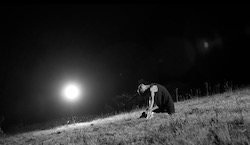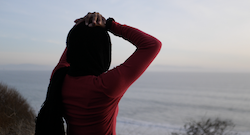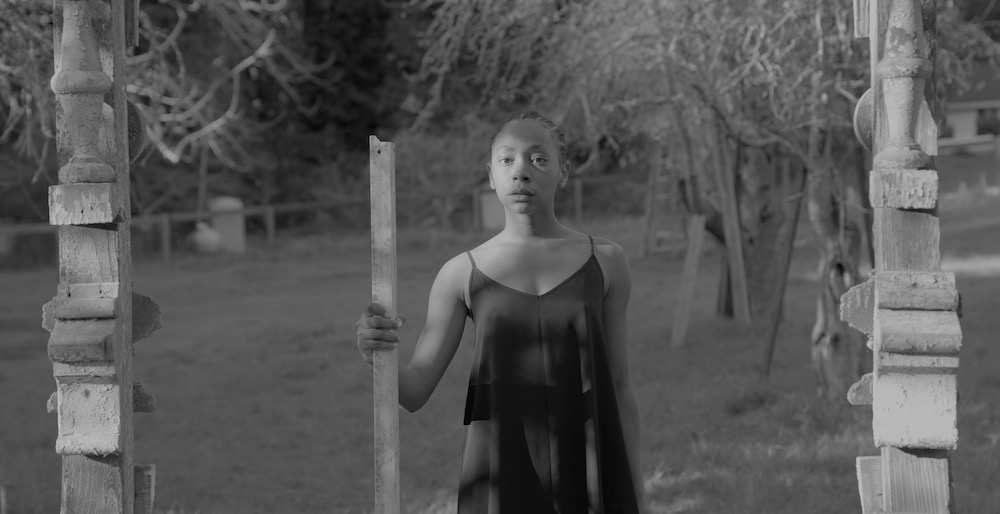January 31, 2021.
Through vimeo.com.
Art can act as a mirror, they say. How so? It can make us ask questions, and see things previously unseen, that can help us to better understand ourselves and the world around us. This COVID era has led many of us — with extra free time and meaningful questions swirling in the ether — to reflect on ourselves, our lives and our world. Hive Creative Company’s Seek was the kind of work that can propel and widen, or conversely shape and polish, such deep and meaningful reflection. At a time when many are grieving the loss of loved ones and/or thinking on life’s big questions, this work surfaces those questions in a way that keeps open space for further questions. In a wider sense, if art is the mirror, what do we see, the work seems to ask. Nathan Hirschaut directed and choreographed the work.

It begins with resonating tones (score by Assaf Shatil), and a woman (Zoe Hollinshead) walks with a shiny metal disc, in which her reflection shines back at her. She wears a simple dark dress, making a unified aesthetic with the dimmed tones of the film. Text at the bottom of the piece reads “I remember a glimmer,” with tonally rich singing (from Lydia Ghram) to accompany her. She separates the plates and then moves in the shape they created through the space, seeing her reflection in varied places within it. Spinning them away and then joining them back together, she makes a new shape and sequence of movement in her body to follow the movement of those shiny objects.
Finally, she sees her reflection in the last plate, with fancy metalwork on the outside. She rises, then runs forward and back. The camera pans back (cinematography by Alex Sargent), so that for the first time we see her directly rather than through her reflection — what feels like a notable shift. Slowly, she picks up the plates, the plate with the fancy outer metalwork somehow now hanging. It’s her mirror, and the art at hand can be ours. What do we see in ourselves? Are we shifting it aside? Moving forward or backward? What is that experience for us? These questions bubble up in my mind like a geyser.
The screen goes black, and then there are words: “I chased freedom.” The same woman runs through a forest. Light and shadow moves over her skin as she runs under trees. Her long legs seem to eat up the path, but there appears to still be far to go. Even stumbling once or twice, crouching lower, she never stops moving forward. The score adds mystery and a sense of determination, of resoluteness to the atmosphere. The final shot is of the path ahead — seemingly never-ending. Ever onward she could run, into endless space ahead.
Another cut to a black screen leads into more words: “I ended up empty.” She stands in a large, grassy space, lit from above by one big bright light. She falls, rises and finds expansiveness through movements such as kicking to her side. She gazes around as if searching, and not finding grabs at grass — seemingly in frustration. The score shifts the emotional quality here to an anxious desperation but one also infused with the obstructed energy of lacking hope. Her frustration seeming to escalate, her grass-throwing speeds up. Finally, she looks around, more slowly and quizzically, almost as if wondering how she could have gotten here.
The words leading into the next section, again scrawling across a black screen, are “I was led by loss.” She swims in a pool, sinking until she is underwater. Frighteningly, she has a rope around her foot. She manages to take it off, pulls it toward her to reach its end, at which she finds lilies. She gazes upon them, and then lets them sink to the pool’s bottom. The flowers sinking, illuminated by refracted underwater light; it’s an incredibly striking and poignant image. I think of grief, of losing loved ones (lilies being a symbol of grieving in Western culture) — an all-too common experience in this COVID-affected world.

“I made it to other worlds” are the next words. In a space half-natural, half-manicured by man, she gracefully walks stone to stone. The camera artfully focuses on her feet as she balances. She finds a long, thin piece of white wood, and — as if exploring newfound possibilities — she balances and manipulates it while sitting and standing. Still exploring, she walks to a building and drums her fingers on its different nooks and crannies. Interestingly, as piano notes play, she taps and grazes her fingers as if playing on the piano. As she builds a structure with rocks and wood, the screen fades to black again. There is a feeling of creativity, exploration and mystery at hand.
“I prayed for entry of all other beings” are the words in transition to the next section. On a rock above a vast shoreline, her back to it and sitting on her heels, she moves through her upper body only — settled, resolute. Yet, there is pleading and desperation to her movement. There’s also uncertainty and even a bit of fear in her eyes and facial expression. Along with a mysterious and hauntingly beautiful score, we hear a woman’s voice saying words such as “ancestors”, “family”, “I pray”. Not all of these words are audible, but this feels purposeful and truthful; as some people pray, they pray aloud, but it’s a low and quiet speaking to themselves. It is only for themselves and the divinity to which they pray, whatever that may be.
Finally, the woman slowly, yet steadily and deliberately, crosses her arms over her chest and drops her gaze downward. Her prayer has been sent up. What will be will be. The waves continue to crash behind her, nature’s rhythm omnipresent in a continuous cycle no matter what may be happening in her human experience. There is a moment here before the screen cuts to black again and the work’s fades into view across the screen — a moment to ponder, to meditate, to absorb or just to breathe. After experiencing this work, there is much to ponder and to meditate on, even if that is filled with uncertainty for the viewer. Sometimes further questions are more valuable than answers — something excellent art like Hive Creative Company’s Seek can make clear.
By Kathryn Boland of Dance Informa.















